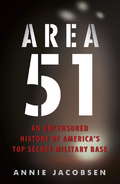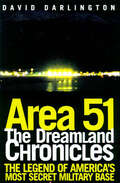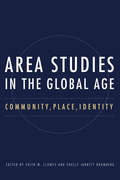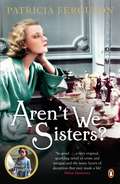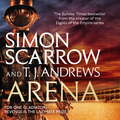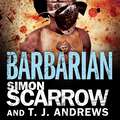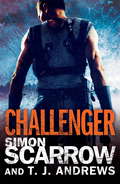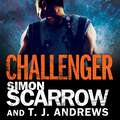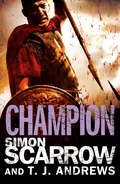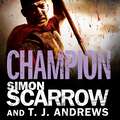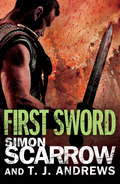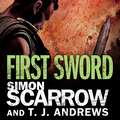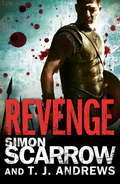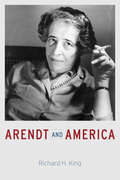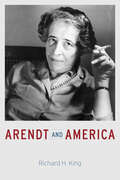- Table View
- List View
Area 51: An Uncensored History of America's Top Secret Military Base
by Annie JacobsenThe explosive, untold story of the Cold War's biggest secret from the bestselling author of NUCLEAR WAR: A SCENARIO'An extraordinary book' DAILY EXPRESS'Revelatory . . . the research is compellingly hard-hitting' NEW YORK TIMESIt is the most famous military installation in the world. And no credible insider has ever divulged the truth about his time inside of it. Until now. This is the first book based on interviews with scientists, pilots, and engineers - 58 in total - who provide an unprecedented look into the mysterious activities of a top-secret base, from the Cold War to today. With a jaw-dropping ending, it proves that facts are often more fantastic than fiction, especially when the distinction is almost impossible to make.
Area 51: The Dreamland Chronicles
by David DarlingtonArea 51, Dreamland, Groom Lake, Paradise Ranch, Watertown Strip, the Box: all refer to the top-secret research installation, located a hundred miles north of Las Vegas, which, for many, has come to stand for all that is shadowy and nefarious about the military-industrial-intelligence complex. Built under the direction of the CIA in the 1950s, the base served as the original test site for the U-2 spy plane and F-117 stealth fighter jet. In more recent years, Area 51 has spurred public interest from its role in the government's $30 billion "Black Budget," from legal claims of worker illness due to toxic burning, and from sensational charges about captured alien spacecraft. It has also given birth to a feisty guerrilla subculture bent on exploding the secrecy surrounding this mysterious spot. David Darlington unfolds the history, legs, and characters involved with Area 51, weaving a weird tale of intrigue and outrage and UFOs that speaks volumes about popular culture and American democracy at the of the twentieth century.
Area Studies in the Global Age: Community, Place, Identity
This interdisciplinary volume is a new introduction to area studies in the framework of whole-world thinking. Emerging in the United States after World War II, area studies have proven indispensable to American integration in the world. They serve two main purposes: to equip future experts with rich cultural-historical and political-economic knowledge of a world area in its global context and advanced foreign language proficiency, and to provide interested readers with well-founded analyses of a vast array of the world's communities. Area Studies in the Global Age examines the interrelation between three constructions central to any culture—community, place, and identity—and builds on research by scholars specializing in diverse world areas, including Africa; Central, East, and North Asia; Eastern and East Central Europe; and Latin America. In contrast to sometimes oversimplified, globalized thinking, the studies featured here argue for the importance of understanding particular human experience and the actual effects of global changes on real people's lives. The rituals, narratives, symbols, and archetypes that define a community, as well as the spaces to which communities attach meaning, are crucial to members' self-perception and sense of agency. Editors Edith W. Clowes and Shelly Jarrett Bromberg have put into practice the original mission of US area studies, which were intended to employ both social science and humanities research methods. This important study presents and applies a variety of methodologies, including interviews and surveys; the construction of databases; the analysis of public rituals and symbols; the examination of archival documents as well as contemporary public commentary; and the close reading and interpretation of fiction, art, buildings, cities, and other creatively produced works in their social contexts. Designed for advanced undergraduate and beginning graduate students in allied disciplines, Clowes and Bromberg's volume will also appeal to readers interested in internationally focused humanities and social sciences.
Aren't We Sisters?
by Patricia FergusonFollowing on from The Midwife's Daughter, Aren't We Sisters? is a gripping novel about buried secrets and unlikely friendship.Norah Thornby can no longer afford to live in her grand family home in the centre of Silkhampton. Unless, perhaps, she can find a respectable lodger.But Nurse Lettie Quick is not nearly as respectable as she seems. What's really going on at the clinic she has opened? And why has she chosen Silkhampton?Meanwhile the beautiful Rae Grainger has found the perfect place to stay, in an isolated house miles away from the town. It's certainly rather creepy, especially at candlelit bedtime, but Rae knows that all she has to do is stay out of sight, until others - paid, professional others - are ready to take her little problem away. Then she can just forget the whole ghastly business . . . can't she?No one guesses, of course, that there's a killer quietly at work in Silkhampton; that in one way or another all three women are in danger . . .
Arena
by Simon Scarrow T. J. AndrewsARENA is a Sunday Times bestselling novel from Simon Scarrow, author of CENTURION, THE GLADIATOR and BRITANNIA, and T.J. Andrews. Perfect for fans of Bernard Cornwell.It is AD 41. The city of Rome is a dangerous place. Optio Macro of the Second Legion, recently decorated for courage on the battlefield, can't wait to leave the teeming city behind. He's dismayed when he's compelled to stay in Rome to train Marcus Valerius Pavo, a young gladiatorial recruit. Though fearless Pavo has fought for his life before, he's a novice in the arena. But he's a driven man, with a goal dearer than survival - to avenge his father's death at the hands of a champion gladiator. Will he live to face his nemesis?ARENA has previously been published as five separate ebook novellas. This edition brings the complete series together.
Arena
by Simon Scarrow T. J. AndrewsARENA is a Sunday Times bestselling novel from Simon Scarrow, author of CENTURION, THE GLADIATOR and BRITANNIA, and T.J. Andrews. Perfect for fans of Bernard Cornwell.It is AD 41. The city of Rome is a dangerous place. Optio Macro of the Second Legion, recently decorated for courage on the battlefield, can't wait to leave the teeming city behind. He's dismayed when he's compelled to stay in Rome to train Marcus Valerius Pavo, a young gladiatorial recruit. Though fearless Pavo has fought for his life before, he's a novice in the arena. But he's a driven man, with a goal dearer than survival - to avenge his father's death at the hands of a champion gladiator. Will he live to face his nemesis?ARENA has previously been published as five separate ebook novellas. This print edition brings the complete series together.
Arena
by Simon Scarrow T. J. AndrewsARENA is a Sunday Times bestselling novel from Simon Scarrow, author of INVICTUS, CENTURION and THE GLADIATOR, and T.J. Andrews. Perfect for fans of Bernard Cornwell. Praise for Simon Scarrow's gripping novels: 'Ferocious and compelling' Daily ExpressIt is AD 41. The city of Rome is a dangerous place.Optio Macro of the Second Legion, recently decorated for courage on the battlefield, can't wait to leave the teeming city behind. He's dismayed when he's compelled to stay in Rome to train Marcus Valerius Pavo, a young gladiatorial recruit. Though fearless Pavo has fought for his life before, he's a novice in the arenas. But he's a driven man, with a goal dearer than survival - to avenge his father's death at the hands of a champion gladiator. Will he live to face his nemesis?ARENA has previously been published as five separate ebook novellas. This print edition brings the complete series together.(P)2013 Headline Publishing Group Ltd
Arena: Barbarian (Part One of the Roman Arena Series)
by Simon Scarrow T. J. AndrewsThe first in a series of action-packed novellas set in Ancient Rome introducing Pavo, a novice gladiator, and featuring Simon Scarrow's ongoing soldier character Optio Macro.It is AD 41. The savage Gaul Britomaris has defeated the best of the Roman gladiators in the arena. Now a young volunteer, Marcus Valerius Pavo, the son of a murdered general, has been given a month to prepare to face Britomaris in a fight which only one man can survive. He is to be trained by veteran soldier Macro, who fears for his young trainee's chances. But Pavo is motivated by more than a simple desire for victory or survival, and Britomaris may yet be facing his most dangerous opponent...
Arena: Barbarian (Part One of the Roman Arena Series)
by Simon Scarrow T. J. AndrewsThe first in an ebook-exclusive series of action-packed novellas set in Ancient Rome introducing Pavo, a novice gladiator, and featuring Simon Scarrow's ongoing soldier character Optio Macro.It is AD 41. The savage Gaul Britomaris has defeated the best of the Roman gladiators in the arena. Now a young volunteer, Marcus Valerius Pavo, the son of a murdered general, has been given a month to prepare to face Britomaris in a fight which only one man can survive. He is to be trained by veteran soldier Macro, who fears for his young trainee's chances. But Pavo is motivated by more than a simple desire for victory or survival, and Britomaris may yet be facing his most dangerous opponent...Simon Scarrow supports the Bansang Hospital Appeal ? learn more at www.bansanghospitalappeal.org. He will be donating his earnings from the sale of this book to the Appeal.
Arena: Barbarian (Roman Arena #1)
by Simon Scarrow T. J. AndrewsThe first in a series of action-packed novellas set in Ancient Rome introducing Pavo, a novice gladiator, and featuring Simon Scarrow's ongoing soldier character Optio Macro.It is AD 41. The savage Gaul Britomaris has defeated the best of the Roman gladiators in the arena. Now a young volunteer, Marcus Valerius Pavo, the son of a murdered general, has been given a month to prepare to face Britomaris in a fight which only one man can survive. He is to be trained by veteran soldier Macro, who fears for his young trainee's chances. But Pavo is motivated by more than a simple desire for victory or survival, and Britomaris may yet be facing his most dangerous opponent...(P)2018 Headline Publishing Group Ltd
Arena: Challenger (Part Two of the Roman Arena Series)
by Simon Scarrow T. J. AndrewsThe second novella in Simon Scarrow's Roman Arena series, following novice gladiator Pavo's next gruelling test, which will put mentor Macro's loyalties on the line.Rome under the rule of the ruthless new Emperor Claudius is a dangerous place. Condemned to gladiator school Marcus Valerius Pavo, the son of a treasonous general, is a celebrated hero following a dramatic victory in the arena. Now he finds himself pitted against one of the greatest gladiators who ever lived: Decimus Cominius Denter. Though Denter has fallen on harder times he is still a formidable opponent, and it is up to newly decorated Macro to whip him into shape. But as the much-heralded fight descends into chaos and riots threaten to engulf the city, Macro must choose between his duty to Rome and his loyalty to Pavo...
Arena: Challenger (Part Two of the Roman Arena Series)
by Simon Scarrow T. J. AndrewsThe second ebook-exclusive novella in Simon Scarrow's Roman Arena series, following novice gladiator Pavo's next gruelling test, which will put mentor Macro's loyalties on the line.Rome under the rule of the ruthless new Emperor Claudius is a dangerous place. Condemned to gladiator school Marcus Valerius Pavo, the son of a treasonous general, is a celebrated hero following a dramatic victory in the arena. Now he finds himself pitted against one of the greatest gladiators who ever lived: Decimus Cominius Denter. Though Denter has fallen on harder times he is still a formidable opponent, and it is up to newly decorated Macro to whip him into shape. But as the much-heralded fight descends into chaos and riots threaten to engulf the city, Macro must choose between his duty to Rome and his loyalty to Pavo...Simon Scarrow supports the Bansang Hospital Appeal ? learn more at www.bansanghospitalappeal.org. He will be donating his earnings from the sale of this book to the Appeal.
Arena: Challenger (Roman Arena #2)
by Simon Scarrow T. J. AndrewsThe second novella in Simon Scarrow's Roman Arena series, following novice gladiator Pavo's next gruelling test, which will put mentor Macro's loyalties on the line.Rome under the rule of the ruthless new Emperor Claudius is a dangerous place. Condemned to gladiator school Marcus Valerius Pavo, the son of a treasonous general, is a celebrated hero following a dramatic victory in the arena. Now he finds himself pitted against one of the greatest gladiators who ever lived: Decimus Cominius Denter. Though Denter has fallen on harder times he is still a formidable opponent, and it is up to newly decorated Macro to whip him into shape. But as the much-heralded fight descends into chaos and riots threaten to engulf the city, Macro must choose between his duty to Rome and his loyalty to Pavo...(P)2018 Headline Publishing Group Ltd
Arena: Champion (Part Five of the Roman Arena Series)
by Simon Scarrow T. J. AndrewsThe fifth and final instalment in Simon Scarrow's electrifying ARENA series sees gladiator Pavo face his most gruelling battle yet as strives to avenge his father's death.From the moment his father was executed in the arena for an act of treason, former military tribune and condemned gladiator Marcus Valerius Pavo has burned with the desire for revenge. Now all that stands between Pavo and victory is a man considered by many to be the greatest gladiator to have ever lived: Hermes. But even with Optio Macro as his trainer, and the help of the snakish imperial secretary, defeating Hermes appears an impossible task. With a conspiracy unfolding within the walls of the palace and a storm gathering over Rome, Pavo will have to call on everything he has learned under Macro if he is to his triumph over his father's killer - and become the champion of the arena...
Arena: Champion (Roman Arena #5)
by Simon Scarrow T. J. AndrewsThe fifth and final instalment in Simon Scarrow's electrifying ARENA series sees gladiator Pavo face his most gruelling battle yet as strives to avenge his father's death.From the moment his father was executed in the arena for an act of treason, former military tribune and condemned gladiator Marcus Valerius Pavo has burned with the desire for revenge. Now all that stands between Pavo and victory is a man considered by many to be the greatest gladiator to have ever lived: Hermes. But even with Optio Macro as his trainer, and the help of the snakish imperial secretary, defeating Hermes appears an impossible task. With a conspiracy unfolding within the walls of the palace and a storm gathering over Rome, Pavo will have to call on everything he has learned under Macro if he is to his triumph over his father's killer - and become the champion of the arena...(P)2018 Headline Publishing Group Ltd
Arena: First Sword (Part Three of the Roman Arena Series)
by Simon Scarrow T. J. AndrewsThe third novella in Simon Scarrow's Roman Arena series sees gladiator Pavo and mentor Macro fight for their lives amid a bloody revolt.The imperial gladiator school in Capua: once the pride of the Roman Empire, lately driven to the brink of ruin by a greedy lanista. Now the school welcomes its newest recruit: Marcus Valerius Pavo, the high-born gladiator with a string of impressive victories to his name, sworn to seek revenge for the brutal murder of his father. Meanwhile Lucius Cornelius Macro, the decorated optio of the Second Legion, has been appointed as the school's new lanista. Macro faces a race against time to turn the school around before the start of the games in Rome, held in honour of the new Emperor. But when a notorious tribal warrior sets in motion a violent uprising, Macro and Pavo find themselves caught in a desperate struggle for survival...
Arena: First Sword (Part Three of the Roman Arena Series)
by Simon ScarrowThe third novella in Simon Scarrow's ebook-exclusive Roman Arena series sees gladiator Pavo and mentor Macro fight for their lives amid a bloody revolt. The imperial gladiator school in Capua: once the pride of the Roman Empire, lately driven to the brink of ruin by a greedy lanista. Now the school welcomes its newest recruit: Marcus Valerius Pavo, the high-born gladiator with a string of impressive victories to his name, sworn to seek revenge for the brutal murder of his father. Meanwhile Lucius Cornelius Macro, the decorated optio of the Second Legion, has been appointed as the school's new lanista. Macro faces a race against time to turn the school around before the start of the games in Rome, held in honour of the new Emperor. But when a notorious tribal warrior sets in motion a violent uprising, Macro and Pavo find themselves caught in a desperate struggle for survival... Simon Scarrow supports the Bansang Hospital Appeal ? learn more at www.bansanghospitalappeal.org. He will be donating his earnings from the sale of this book to the Appeal.
Arena: First Sword (Roman Arena #1)
by Simon Scarrow T. J. AndrewsThe third novella in Simon Scarrow's Roman Arena series sees gladiator Pavo and mentor Macro fight for their lives amid a bloody revolt.The imperial gladiator school in Capua: once the pride of the Roman Empire, lately driven to the brink of ruin by a greedy lanista. Now the school welcomes its newest recruit: Marcus Valerius Pavo, the high-born gladiator with a string of impressive victories to his name, sworn to seek revenge for the brutal murder of his father. Meanwhile Lucius Cornelius Macro, the decorated optio of the Second Legion, has been appointed as the school's new lanista. Macro faces a race against time to turn the school around before the start of the games in Rome, held in honour of the new Emperor. But when a notorious tribal warrior sets in motion a violent uprising, Macro and Pavo find themselves caught in a desperate struggle for survival...(P)2018 Headline Publishing Group Ltd
Arena: Revenge (Part Four of the Roman Arena Series)
by Simon Scarrow T. J. AndrewsThe opening day of the Games in Rome is a time for celebration in honour of the new Emperor. But for Marcus Valerius Pavo, a young military tribune fallen from grace, only despair awaits. Along with former mentor, Optio Macro, Pavo must fight for his life in a ferocious beast hunt. Battling against lions and bears, he'll have to use all his wits to survive, as well as the help of a hated former rival. But when Pavo achieves a stunning victory, his reward is to be condemned to death in a chaotic free-for-all. Now the young gladiator faces a race against time to triumph over the odds, save his son - and exact the ultimate revenge over the Emperor...
Arena: Revenge (Part Four of the Roman Arena Series)
by Simon Scarrow T. J. AndrewsThe opening day of the Games in Rome is a time for celebration in honour of the new Emperor. But for Marcus Valerius Pavo, a young military tribune fallen from grace, only despair awaits. Along with former mentor, Optio Macro, Pavo must fight for his life in a ferocious beast hunt. Battling against lions and bears, he'll have to use all his wits to survive, as well as the help of a hated former rival. But when Pavo achieves a stunning victory, his reward is to be condemned to death in a chaotic free-for-all. Now the young gladiator faces a race against time to triumph over the odds, save his son - and exact the ultimate revenge over the Emperor...Simon Scarrow supports the Bansang Hospital Appeal - learn more at www.bansanghospitalappeal.org. He will be donating his earnings from the sale of this book to the Appeal.
Arena: Revenge (Roman Arena #4)
by Simon Scarrow T. J. AndrewsThe opening day of the Games in Rome is a time for celebration in honour of the new Emperor. But for Marcus Valerius Pavo, a young military tribune fallen from grace, only despair awaits. Along with former mentor, Optio Macro, Pavo must fight for his life in a ferocious beast hunt. Battling against lions and bears, he'll have to use all his wits to survive, as well as the help of a hated former rival. But when Pavo achieves a stunning victory, his reward is to be condemned to death in a chaotic free-for-all. Now the young gladiator faces a race against time to triumph over the odds, save his son - and exact the ultimate revenge over the Emperor...(P)2018 Headline Publishing Group Ltd
Arendt and America
by Richard H. KingGerman-Jewish political philosopher Hannah Arendt (1906-75) fled from the Nazis to New York in 1941, and during the next thirty years in America she wrote her best-known and most influential works, such as The Human Condition, The Origins of Totalitarianism, and On Revolution. Yet, despite the fact that a substantial portion of her oeuvre was written in America, not Europe, no one has directly considered the influence of America on her thought--until now. In Arendt and America, historian Richard H. King argues that while all of Arendt's work was haunted by her experience of totalitarianism, it was only in her adopted homeland that she was able to formulate the idea of the modern republic as an alternative to totalitarian rule. Situating Arendt within the context of U. S. intellectual, political, and social history, King reveals how Arendt developed a fascination with the political thought of the Founding Fathers. King also re-creates her intellectual exchanges with American friends and colleagues, such as Dwight Macdonald and Mary McCarthy, and shows how her lively correspondence with sociologist David Riesman helped her understand modern American culture and society. In the last section of Arendt and America, King sets out the context in which the Eichmann controversy took place and follows the debate about "the banality of evil" that has continued ever since. As King shows, Arendt's work, regardless of focus, was shaped by postwar American thought, culture, and politics, including the Civil Rights Movement and the Cold War. For Arendt, the United States was much more than a refuge from Nazi Germany; it was a stimulus to rethink the political, ethical, and historical traditions of human culture. This authoritative combination of intellectual history and biography offers a unique approach for thinking about the influence of America on Arendt's ideas and also the effect of her ideas on American thought.
Arendt and America
by Richard H. KingGerman-Jewish political philosopher Hannah Arendt (1906–75) fled from the Nazis to New York in 1941, and during the next thirty years in America she wrote her best-known and most influential works, such as The Human Condition, The Origins of Totalitarianism, and On Revolution. Yet, despite the fact that a substantial portion of her oeuvre was written in America, not Europe, no one has directly considered the influence of America on her thought—until now. In Arendt and America, historian Richard H. King argues that while all of Arendt’s work was haunted by her experience of totalitarianism, it was only in her adopted homeland that she was able to formulate the idea of the modern republic as an alternative to totalitarian rule. Situating Arendt within the context of U.S. intellectual, political, and social history, King reveals how Arendt developed a fascination with the political thought of the Founding Fathers. King also re-creates her intellectual exchanges with American friends and colleagues, such as Dwight Macdonald and Mary McCarthy, and shows how her lively correspondence with sociologist David Riesman helped her understand modern American culture and society. In the last section of Arendt and America, King sets out the context in which the Eichmann controversy took place and follows the debate about “the banality of evil” that has continued ever since. As King shows, Arendt’s work, regardless of focus, was shaped by postwar American thought, culture, and politics, including the Civil Rights Movement and the Cold War. For Arendt, the United States was much more than a refuge from Nazi Germany; it was a stimulus to rethink the political, ethical, and historical traditions of human culture. This authoritative combination of intellectual history and biography offers a unique approach for thinking about the influence of America on Arendt’s ideas and also the effect of her ideas on American thought.
Arendt's Judgment: Freedom, Responsibility, Citizenship
by Jonathan Peter SchwartzIn Arendt's Judgment, Jonathan Peter Schwartz explores the nature of human judgment, the subject of the planned third volume of Hannah Arendt's The Life of the Mind, which was left unwritten at the time of her death. Arguing that previous interpretations of Arendt failed to fully appreciate the central place of judgment in her thought, Schwartz contends that understanding Arendt's ideas requires not only interpreting her published work but also reconstructing her thinking from a broader range of sources, including her various essays, lecture course notes, unpublished material, and correspondence. When these sources are taken into account, it becomes clear that, for Arendt, political judgment was the answer to the question of how human freedom could be realized in the modern world.This new approach to understanding Arendt leads to what Schwartz argues are original insights Arendt can teach us about the nature of politics beyond sovereignty and the role of human agency in history. Above all, her novel understanding of the authentic nature and purpose of political philosophy is finally revealed. Schwartz claims that in her theory of political judgment Arendt presented a vision of political philosophy that is improved and deepened by the contributions of ordinary, active citizens. Along with challenging previous interpretations, Arendt's Judgment provides a roadmap to her published and unpublished work for scholars and students.
Arendt's Solidarity: Anti-Semitism and Racism in the Atlantic World (Cultural Memory in the Present)
by David D. KimHannah Arendt's work inspires many to stand in solidarity against authoritarianism, racial or gender-based violence, climate change, and right-wing populism. But what if a careful analysis of her oeuvre reveals a darker side to this intellectual legacy? What if solidarity, as she conceives of it, is not oriented toward equality, freedom, or justice for all, but creates a barrier to intersectional coalition building? In Arendt's Solidarity, David D. Kim illuminates Arendt's lifelong struggle with this deceptively straightforward yet divisive concept. Drawing upon her publications, unpublished documents, private letters, radio and television interviews, newspaper clippings, and archival marginalia, Kim examines how Arendt refutes solidarity as an effective political force against anti-Semitism, racial injustice, or social inequality. As Kim reveals, this conceptual conundrum follows the arc of Arendt's forced migration across the Atlantic and is directly related to every major concern of hers: Christian neighborly love, friendship, Jewish assimilation, Zionism, National Socialism, the American republic, Black Power, revolution, violence, and the human world. Kim places these thoughts in dialogue with dissenting voices, such as Thomas Mann, Gershom Scholem, Jean-Paul Sartre, James Baldwin, Frantz Fanon, James Forman, and Ralph Ellison. The result is a full-scale reinterpretation of Arendt's oeuvre.
